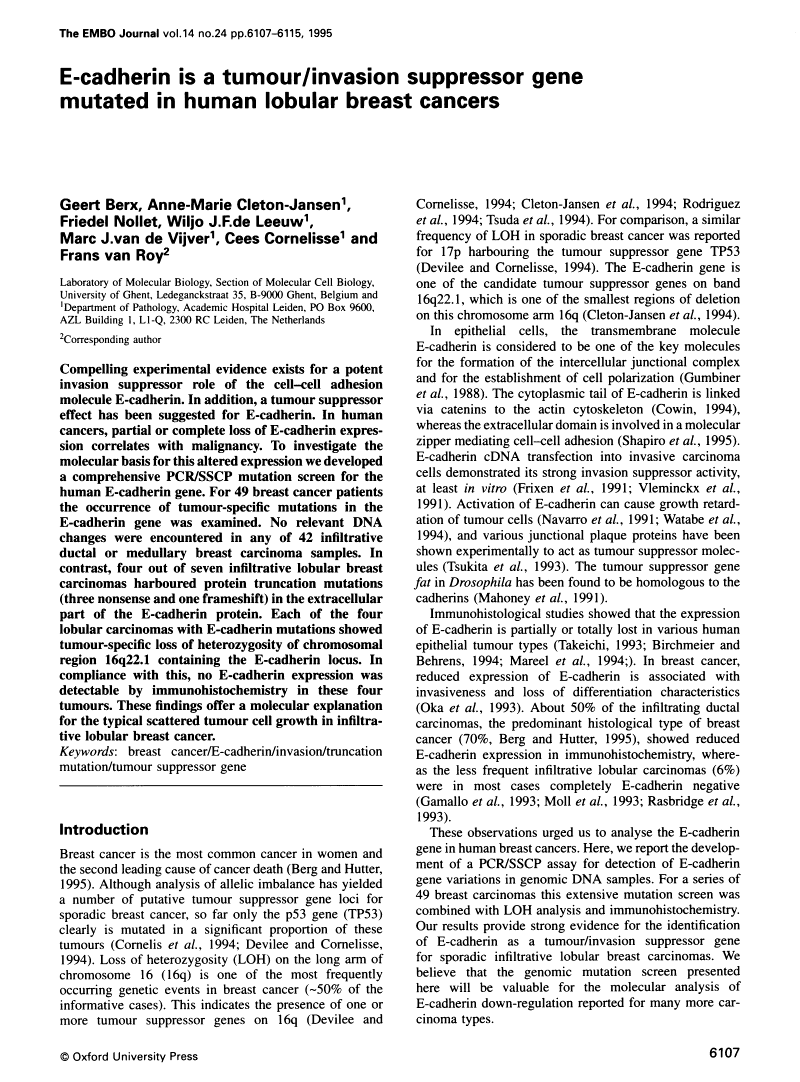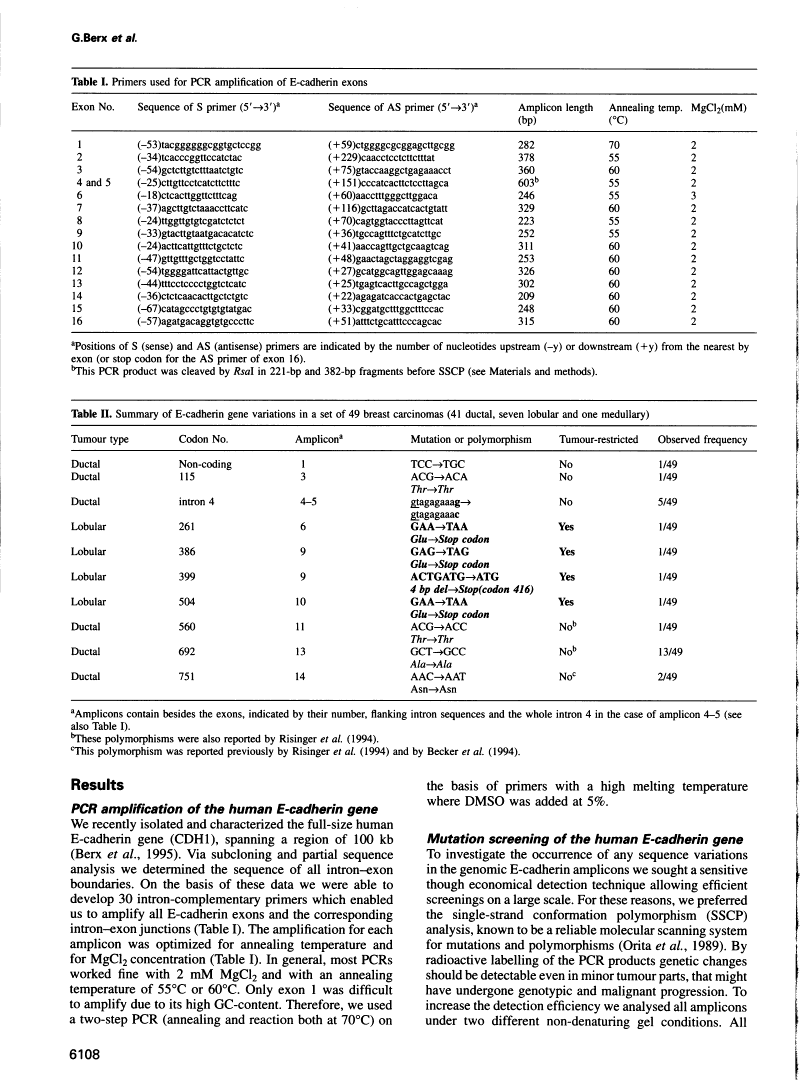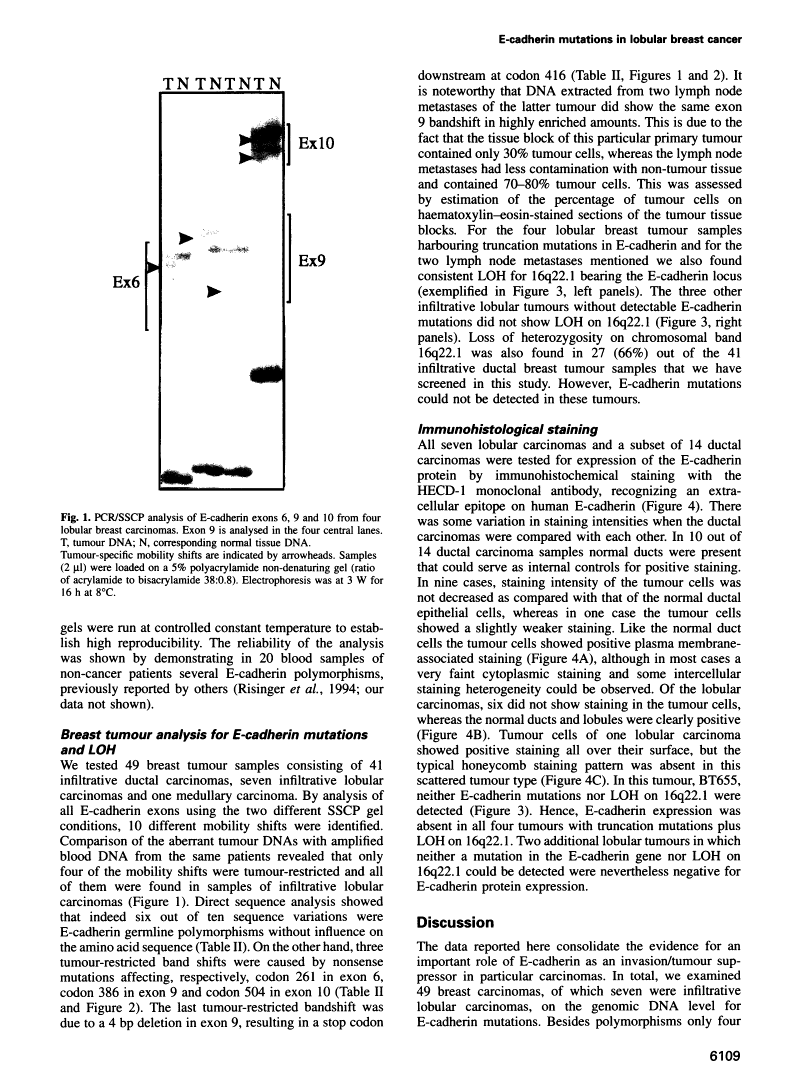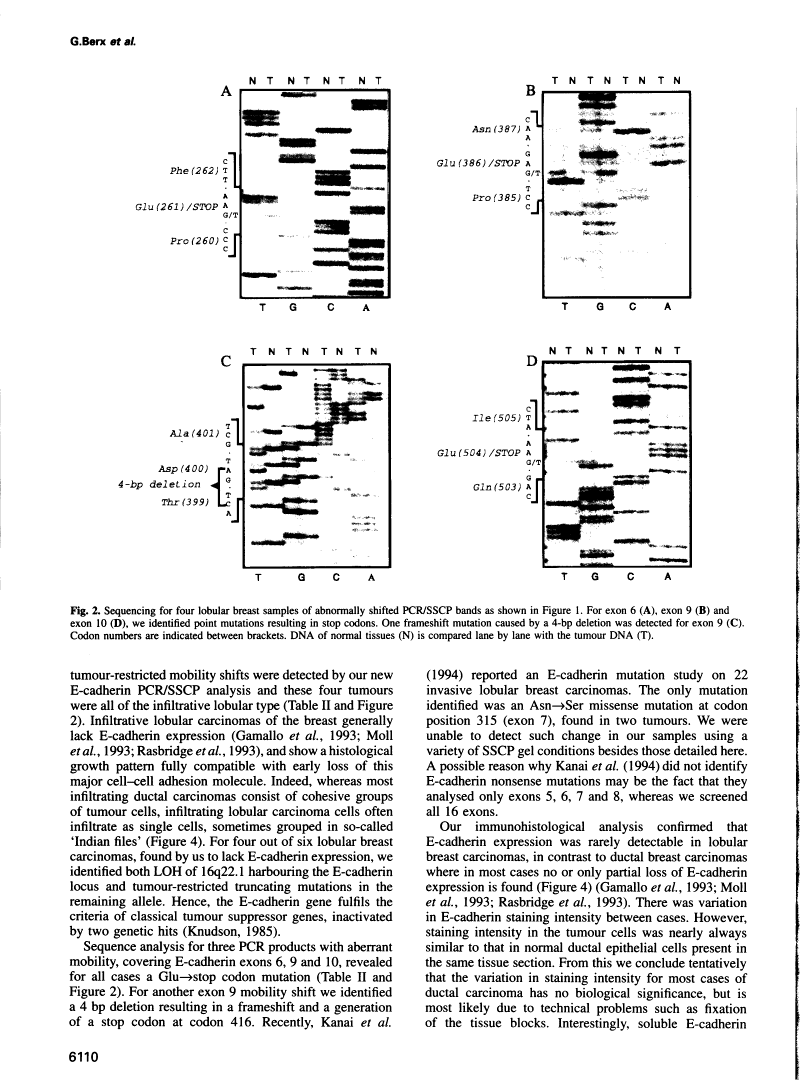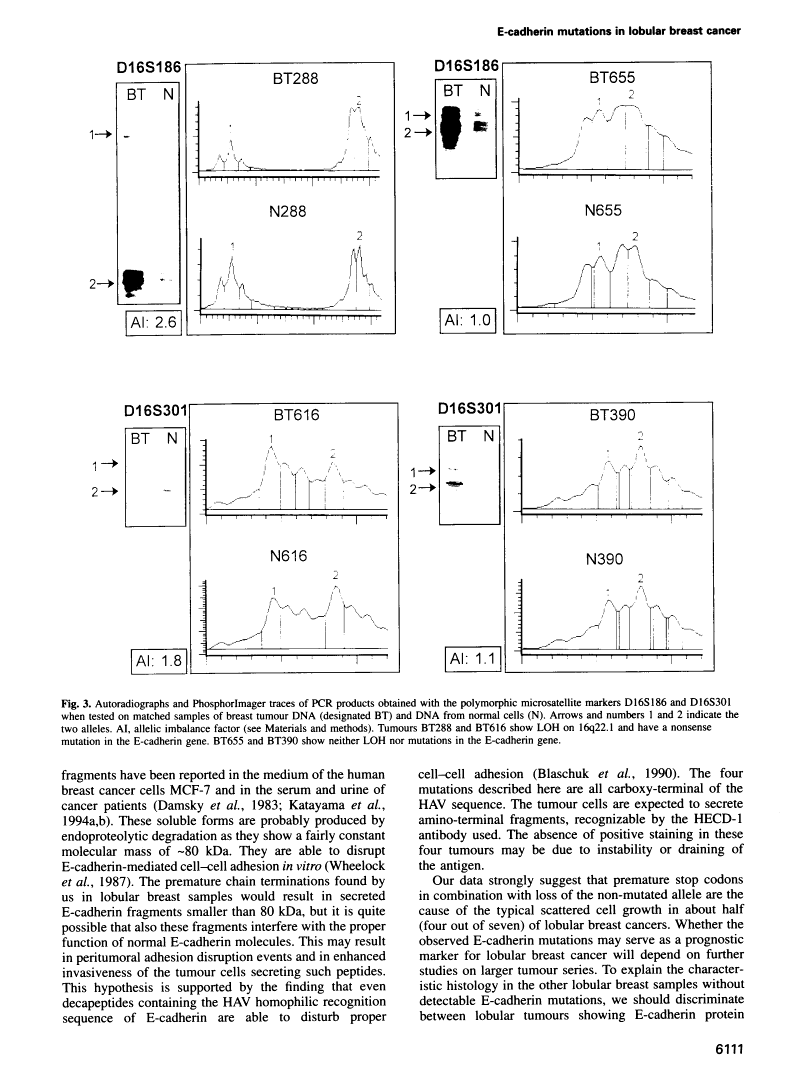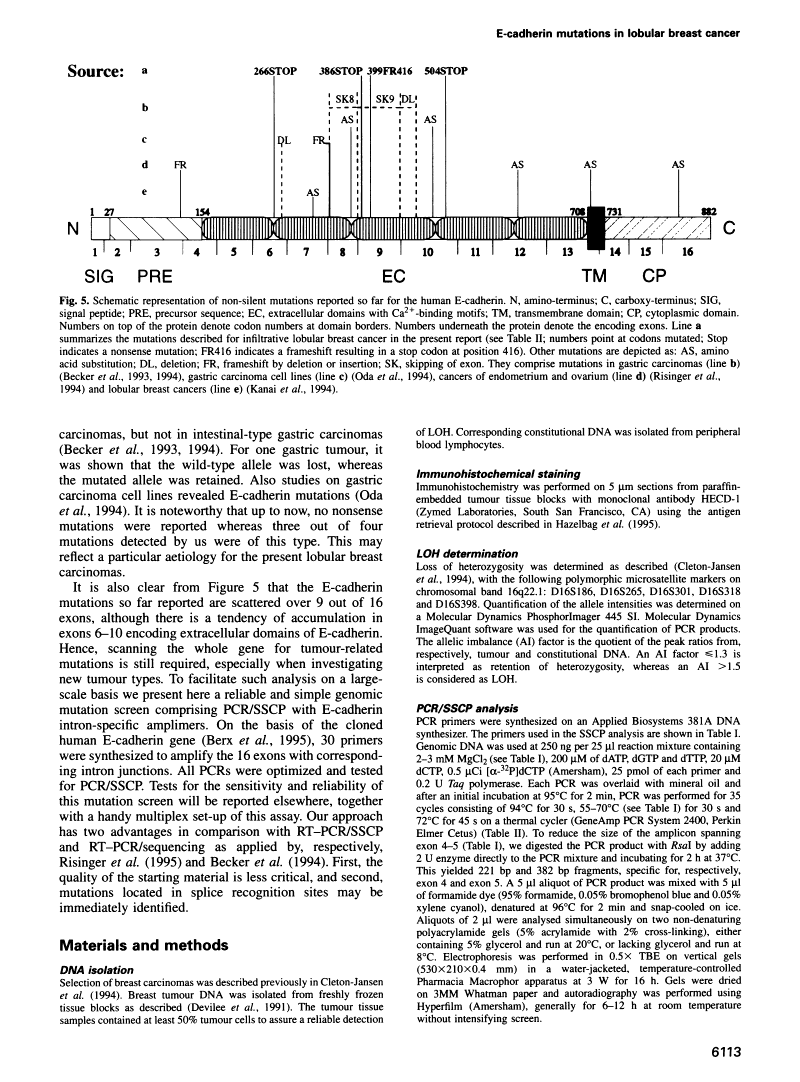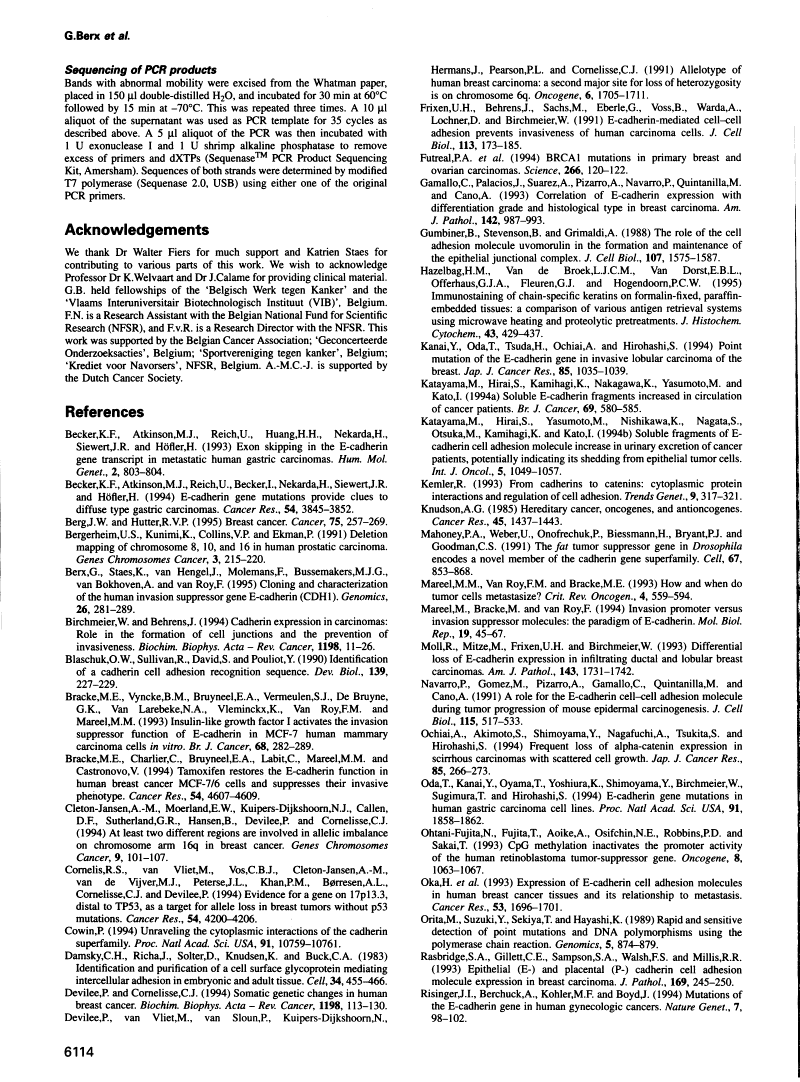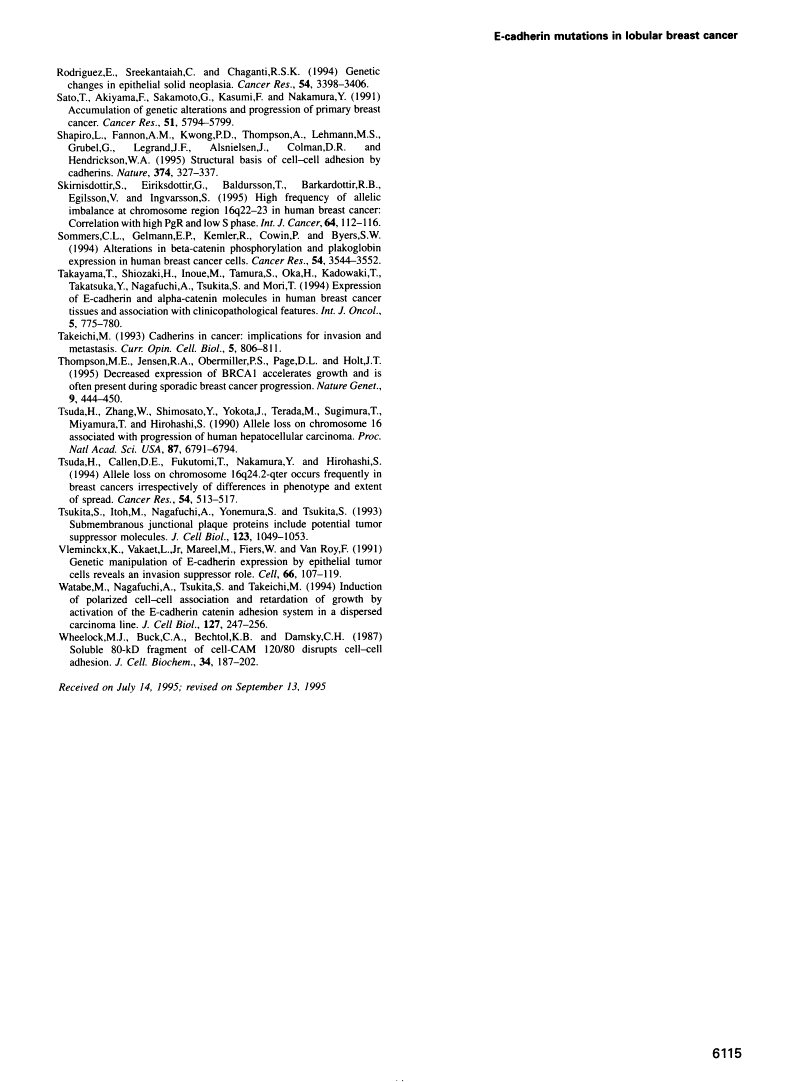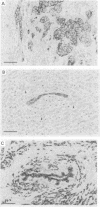Abstract
Free full text

E-cadherin is a tumour/invasion suppressor gene mutated in human lobular breast cancers.
Abstract
Compelling experimental evidence exists for a potent invasion suppressor role of the cell-cell adhesion molecule E-cadherin. In addition, a tumour suppressor effect has been suggested for E-cadherin. In human cancers, partial or complete loss of E-cadherin expression correlates with malignancy. To investigate the molecular basis for this altered expression we developed a comprehensive PCR/SSCP mutation screen for the human E-cadherin gene. For 49 breast cancer patients the occurrence of tumour-specific mutations in the E-cadherin gene was examined. No relevant DNA changes were encountered in any of 42 infiltrative ductal or medullary breast carcinoma samples. In contrast, four out of seven infiltrative lobular breast carcinomas harboured protein truncation mutations (three nonsense and one frameshift) in the extracellular part of the E-cadherin protein. Each of the four lobular carcinomas with E-cadherin mutations showed tumour-specific loss of heterozygosity of chromosomal region 16q22.1 containing the E-cadherin locus. In compliance with this, no E-cadherin expression was detectable by immunohistochemistry in these four tumours. These findings offer a molecular explanation for the typical scattered tumour cell growth in infiltrative lobular breast cancer.
Full text
Full text is available as a scanned copy of the original print version. Get a printable copy (PDF file) of the complete article (2.3M), or click on a page image below to browse page by page. Links to PubMed are also available for Selected References.
Images in this article
Click on the image to see a larger version.
Selected References
These references are in PubMed. This may not be the complete list of references from this article.
- Becker KF, Atkinson MJ, Reich U, Huang HH, Nekarda H, Siewert JR, Höfler H. Exon skipping in the E-cadherin gene transcript in metastatic human gastric carcinomas. Hum Mol Genet. 1993 Jun;2(6):803–804. [Abstract] [Google Scholar]
- Becker KF, Atkinson MJ, Reich U, Becker I, Nekarda H, Siewert JR, Höfler H. E-cadherin gene mutations provide clues to diffuse type gastric carcinomas. Cancer Res. 1994 Jul 15;54(14):3845–3852. [Abstract] [Google Scholar]
- Berg JW, Hutter RV. Breast cancer. Cancer. 1995 Jan 1;75(1 Suppl):257–269. [Abstract] [Google Scholar]
- Bergerheim US, Kunimi K, Collins VP, Ekman P. Deletion mapping of chromosomes 8, 10, and 16 in human prostatic carcinoma. Genes Chromosomes Cancer. 1991 May;3(3):215–220. [Abstract] [Google Scholar]
- Berx G, Staes K, van Hengel J, Molemans F, Bussemakers MJ, van Bokhoven A, van Roy F. Cloning and characterization of the human invasion suppressor gene E-cadherin (CDH1). Genomics. 1995 Mar 20;26(2):281–289. [Abstract] [Google Scholar]
- Birchmeier W, Behrens J. Cadherin expression in carcinomas: role in the formation of cell junctions and the prevention of invasiveness. Biochim Biophys Acta. 1994 May 27;1198(1):11–26. [Abstract] [Google Scholar]
- Blaschuk OW, Sullivan R, David S, Pouliot Y. Identification of a cadherin cell adhesion recognition sequence. Dev Biol. 1990 May;139(1):227–229. [Abstract] [Google Scholar]
- Bracke ME, Vyncke BM, Bruyneel EA, Vermeulen SJ, De Bruyne GK, Van Larebeke NA, Vleminckx K, Van Roy FM, Mareel MM. Insulin-like growth factor I activates the invasion suppressor function of E-cadherin in MCF-7 human mammary carcinoma cells in vitro. Br J Cancer. 1993 Aug;68(2):282–289. [Europe PMC free article] [Abstract] [Google Scholar]
- Bracke ME, Charlier C, Bruyneel EA, Labit C, Mareel MM, Castronovo V. Tamoxifen restores the E-cadherin function in human breast cancer MCF-7/6 cells and suppresses their invasive phenotype. Cancer Res. 1994 Sep 1;54(17):4607–4609. [Abstract] [Google Scholar]
- Cleton-Jansen AM, Moerland EW, Kuipers-Dijkshoorn NJ, Callen DF, Sutherland GR, Hansen B, Devilee P, Cornelisse CJ. At least two different regions are involved in allelic imbalance on chromosome arm 16q in breast cancer. Genes Chromosomes Cancer. 1994 Feb;9(2):101–107. [Abstract] [Google Scholar]
- Cornelis RS, van Vliet M, Vos CB, Cleton-Jansen AM, van de Vijver MJ, Peterse JL, Khan PM, Børresen AL, Cornelisse CJ, Devilee P. Evidence for a gene on 17p13.3, distal to TP53, as a target for allele loss in breast tumors without p53 mutations. Cancer Res. 1994 Aug 1;54(15):4200–4206. [Abstract] [Google Scholar]
- Cowin P. Unraveling the cytoplasmic interactions of the cadherin superfamily. Proc Natl Acad Sci U S A. 1994 Nov 8;91(23):10759–10761. [Europe PMC free article] [Abstract] [Google Scholar]
- Damsky CH, Richa J, Solter D, Knudsen K, Buck CA. Identification and purification of a cell surface glycoprotein mediating intercellular adhesion in embryonic and adult tissue. Cell. 1983 Sep;34(2):455–466. [Abstract] [Google Scholar]
- Devilee P, Cornelisse CJ. Somatic genetic changes in human breast cancer. Biochim Biophys Acta. 1994 Dec 30;1198(2-3):113–130. [Abstract] [Google Scholar]
- Devilee P, van Vliet M, van Sloun P, Kuipers Dijkshoorn N, Hermans J, Pearson PL, Cornelisse CJ. Allelotype of human breast carcinoma: a second major site for loss of heterozygosity is on chromosome 6q. Oncogene. 1991 Sep;6(9):1705–1711. [Abstract] [Google Scholar]
- Frixen UH, Behrens J, Sachs M, Eberle G, Voss B, Warda A, Löchner D, Birchmeier W. E-cadherin-mediated cell-cell adhesion prevents invasiveness of human carcinoma cells. J Cell Biol. 1991 Apr;113(1):173–185. [Europe PMC free article] [Abstract] [Google Scholar]
- Futreal PA, Liu Q, Shattuck-Eidens D, Cochran C, Harshman K, Tavtigian S, Bennett LM, Haugen-Strano A, Swensen J, Miki Y, et al. BRCA1 mutations in primary breast and ovarian carcinomas. Science. 1994 Oct 7;266(5182):120–122. [Abstract] [Google Scholar]
- Gamallo C, Palacios J, Suarez A, Pizarro A, Navarro P, Quintanilla M, Cano A. Correlation of E-cadherin expression with differentiation grade and histological type in breast carcinoma. Am J Pathol. 1993 Apr;142(4):987–993. [Europe PMC free article] [Abstract] [Google Scholar]
- Gumbiner B, Stevenson B, Grimaldi A. The role of the cell adhesion molecule uvomorulin in the formation and maintenance of the epithelial junctional complex. J Cell Biol. 1988 Oct;107(4):1575–1587. [Europe PMC free article] [Abstract] [Google Scholar]
- Hazelbag HM, van den Broek LJ, van Dorst EB, Offerhaus GJ, Fleuren GJ, Hogendoorn PC. Immunostaining of chain-specific keratins on formalin-fixed, paraffin-embedded tissues: a comparison of various antigen retrieval systems using microwave heating and proteolytic pre-treatments. J Histochem Cytochem. 1995 Apr;43(4):429–437. [Abstract] [Google Scholar]
- Kanai Y, Oda T, Tsuda H, Ochiai A, Hirohashi S. Point mutation of the E-cadherin gene in invasive lobular carcinoma of the breast. Jpn J Cancer Res. 1994 Oct;85(10):1035–1039. [Abstract] [Google Scholar]
- Katayama M, Hirai S, Kamihagi K, Nakagawa K, Yasumoto M, Kato I. Soluble E-cadherin fragments increased in circulation of cancer patients. Br J Cancer. 1994 Mar;69(3):580–585. [Europe PMC free article] [Abstract] [Google Scholar]
- Kemler R. From cadherins to catenins: cytoplasmic protein interactions and regulation of cell adhesion. Trends Genet. 1993 Sep;9(9):317–321. [Abstract] [Google Scholar]
- Knudson AG., Jr Hereditary cancer, oncogenes, and antioncogenes. Cancer Res. 1985 Apr;45(4):1437–1443. [Abstract] [Google Scholar]
- Mahoney PA, Weber U, Onofrechuk P, Biessmann H, Bryant PJ, Goodman CS. The fat tumor suppressor gene in Drosophila encodes a novel member of the cadherin gene superfamily. Cell. 1991 Nov 29;67(5):853–868. [Abstract] [Google Scholar]
- Mareel MM, Van Roy FM, Bracke ME. How and when do tumor cells metastasize? Crit Rev Oncog. 1993;4(5):559–594. [Abstract] [Google Scholar]
- Mareel M, Bracke M, Van Roy F. Invasion promoter versus invasion suppressor molecules: the paradigm of E-cadherin. Mol Biol Rep. 1994 Jan;19(1):45–67. [Abstract] [Google Scholar]
- Moll R, Mitze M, Frixen UH, Birchmeier W. Differential loss of E-cadherin expression in infiltrating ductal and lobular breast carcinomas. Am J Pathol. 1993 Dec;143(6):1731–1742. [Europe PMC free article] [Abstract] [Google Scholar]
- Navarro P, Gómez M, Pizarro A, Gamallo C, Quintanilla M, Cano A. A role for the E-cadherin cell-cell adhesion molecule during tumor progression of mouse epidermal carcinogenesis. J Cell Biol. 1991 Oct;115(2):517–533. [Europe PMC free article] [Abstract] [Google Scholar]
- Ochiai A, Akimoto S, Shimoyama Y, Nagafuchi A, Tsukita S, Hirohashi S. Frequent loss of alpha catenin expression in scirrhous carcinomas with scattered cell growth. Jpn J Cancer Res. 1994 Mar;85(3):266–273. [Abstract] [Google Scholar]
- Oda T, Kanai Y, Oyama T, Yoshiura K, Shimoyama Y, Birchmeier W, Sugimura T, Hirohashi S. E-cadherin gene mutations in human gastric carcinoma cell lines. Proc Natl Acad Sci U S A. 1994 Mar 1;91(5):1858–1862. [Europe PMC free article] [Abstract] [Google Scholar]
- Ohtani-Fujita N, Fujita T, Aoike A, Osifchin NE, Robbins PD, Sakai T. CpG methylation inactivates the promoter activity of the human retinoblastoma tumor-suppressor gene. Oncogene. 1993 Apr;8(4):1063–1067. [Abstract] [Google Scholar]
- Oka H, Shiozaki H, Kobayashi K, Inoue M, Tahara H, Kobayashi T, Takatsuka Y, Matsuyoshi N, Hirano S, Takeichi M, et al. Expression of E-cadherin cell adhesion molecules in human breast cancer tissues and its relationship to metastasis. Cancer Res. 1993 Apr 1;53(7):1696–1701. [Abstract] [Google Scholar]
- Orita M, Suzuki Y, Sekiya T, Hayashi K. Rapid and sensitive detection of point mutations and DNA polymorphisms using the polymerase chain reaction. Genomics. 1989 Nov;5(4):874–879. [Abstract] [Google Scholar]
- Rasbridge SA, Gillett CE, Sampson SA, Walsh FS, Millis RR. Epithelial (E-) and placental (P-) cadherin cell adhesion molecule expression in breast carcinoma. J Pathol. 1993 Feb;169(2):245–250. [Abstract] [Google Scholar]
- Risinger JI, Berchuck A, Kohler MF, Boyd J. Mutations of the E-cadherin gene in human gynecologic cancers. Nat Genet. 1994 May;7(1):98–102. [Abstract] [Google Scholar]
- Rodriguez E, Sreekantaiah C, Chaganti RS. Genetic changes in epithelial solid neoplasia. Cancer Res. 1994 Jul 1;54(13):3398–3406. [Abstract] [Google Scholar]
- Sato T, Akiyama F, Sakamoto G, Kasumi F, Nakamura Y. Accumulation of genetic alterations and progression of primary breast cancer. Cancer Res. 1991 Nov 1;51(21):5794–5799. [Abstract] [Google Scholar]
- Shapiro L, Fannon AM, Kwong PD, Thompson A, Lehmann MS, Grübel G, Legrand JF, Als-Nielsen J, Colman DR, Hendrickson WA. Structural basis of cell-cell adhesion by cadherins. Nature. 1995 Mar 23;374(6520):327–337. [Abstract] [Google Scholar]
- Skirnisdottir S, Eiriksdottir G, Baldursson T, Barkardottir RB, Egilsson V, Ingvarrson S. High frequency of allelic imbalance at chromosome region 16q22-23 in human breast cancer: correlation with high PgR and low S phase. Int J Cancer. 1995 Apr 21;64(2):112–116. [Abstract] [Google Scholar]
- Sommers CL, Gelmann EP, Kemler R, Cowin P, Byers SW. Alterations in beta-catenin phosphorylation and plakoglobin expression in human breast cancer cells. Cancer Res. 1994 Jul 1;54(13):3544–3552. [Abstract] [Google Scholar]
- Takeichi M. Cadherins in cancer: implications for invasion and metastasis. Curr Opin Cell Biol. 1993 Oct;5(5):806–811. [Abstract] [Google Scholar]
- Thompson ME, Jensen RA, Obermiller PS, Page DL, Holt JT. Decreased expression of BRCA1 accelerates growth and is often present during sporadic breast cancer progression. Nat Genet. 1995 Apr;9(4):444–450. [Abstract] [Google Scholar]
- Tsuda H, Zhang WD, Shimosato Y, Yokota J, Terada M, Sugimura T, Miyamura T, Hirohashi S. Allele loss on chromosome 16 associated with progression of human hepatocellular carcinoma. Proc Natl Acad Sci U S A. 1990 Sep;87(17):6791–6794. [Europe PMC free article] [Abstract] [Google Scholar]
- Tsuda H, Callen DF, Fukutomi T, Nakamura Y, Hirohashi S. Allele loss on chromosome 16q24.2-qter occurs frequently in breast cancers irrespectively of differences in phenotype and extent of spread. Cancer Res. 1994 Jan 15;54(2):513–517. [Abstract] [Google Scholar]
- Tsukita S, Itoh M, Nagafuchi A, Yonemura S, Tsukita S. Submembranous junctional plaque proteins include potential tumor suppressor molecules. J Cell Biol. 1993 Dec;123(5):1049–1053. [Europe PMC free article] [Abstract] [Google Scholar]
- Vleminckx K, Vakaet L, Jr, Mareel M, Fiers W, van Roy F. Genetic manipulation of E-cadherin expression by epithelial tumor cells reveals an invasion suppressor role. Cell. 1991 Jul 12;66(1):107–119. [Abstract] [Google Scholar]
- Watabe M, Nagafuchi A, Tsukita S, Takeichi M. Induction of polarized cell-cell association and retardation of growth by activation of the E-cadherin-catenin adhesion system in a dispersed carcinoma line. J Cell Biol. 1994 Oct;127(1):247–256. [Europe PMC free article] [Abstract] [Google Scholar]
- Wheelock MJ, Buck CA, Bechtol KB, Damsky CH. Soluble 80-kd fragment of cell-CAM 120/80 disrupts cell-cell adhesion. J Cell Biochem. 1987 Jul;34(3):187–202. [Abstract] [Google Scholar]
Associated Data
Articles from The EMBO Journal are provided here courtesy of Nature Publishing Group
Full text links
Read article at publisher's site: https://doi.org/10.1002/j.1460-2075.1995.tb00301.x
Read article for free, from open access legal sources, via Unpaywall:
https://europepmc.org/articles/pmc394735?pdf=render
Citations & impact
Impact metrics
Citations of article over time
Alternative metrics
Article citations
Prognosis and metabolism with a Golgi apparatus-related genes-based formula in breast cancer.
Medicine (Baltimore), 103(33):e39177, 01 Aug 2024
Cited by: 0 articles | PMID: 39151519 | PMCID: PMC11332736
Insights into E-Cadherin Impairment in CDH1-Unaltered Invasive Lobular Carcinoma: A Comprehensive Bioinformatic Study.
Int J Mol Sci, 25(16):8961, 17 Aug 2024
Cited by: 0 articles | PMID: 39201647 | PMCID: PMC11354486
CDH1 Genotype Exploration in Women With Hereditary Lobular Breast Cancer Phenotype.
JAMA Netw Open, 7(4):e247862, 01 Apr 2024
Cited by: 0 articles | PMID: 38652475 | PMCID: PMC11040411
Microenvironment-induced restoration of cohesive growth associated with focal activation of P-cadherin expression in lobular breast carcinoma metastatic to the colon.
J Pathol Clin Res, 10(2):e12361, 01 Mar 2024
Cited by: 0 articles | PMID: 38618992 | PMCID: PMC10796744
Review Free full text in Europe PMC
RNA modification-related genes illuminate prognostic signature and mechanism in esophageal squamous cell carcinoma.
iScience, 27(3):109327, 24 Feb 2024
Cited by: 1 article | PMID: 38487015
Go to all (442) article citations
Other citations
Data
Similar Articles
To arrive at the top five similar articles we use a word-weighted algorithm to compare words from the Title and Abstract of each citation.
E-cadherin is inactivated in a majority of invasive human lobular breast cancers by truncation mutations throughout its extracellular domain.
Oncogene, 13(9):1919-1925, 01 Nov 1996
Cited by: 289 articles | PMID: 8934538
Simultaneous loss of E-cadherin and catenins in invasive lobular breast cancer and lobular carcinoma in situ.
J Pathol, 183(4):404-411, 01 Dec 1997
Cited by: 189 articles | PMID: 9496256
CDH1 promoter hypermethylation and E-cadherin protein expression in infiltrating breast cancer.
BMC Cancer, 6:48, 02 Mar 2006
Cited by: 100 articles | PMID: 16512896 | PMCID: PMC1523210
E-cadherin and loss of heterozygosity at chromosome 16 in breast carcinogenesis: different genetic pathways in ductal and lobular breast cancer?
Breast Cancer Res, 4(1):5-8, 01 Nov 2001
Cited by: 70 articles | PMID: 11879552 | PMCID: PMC138715
Review Free full text in Europe PMC
